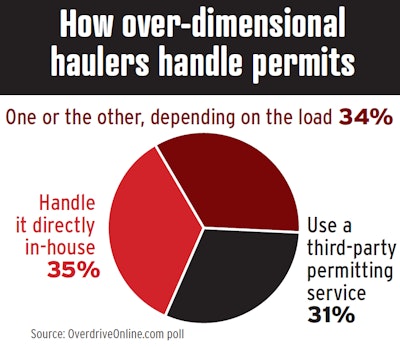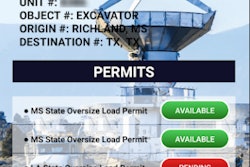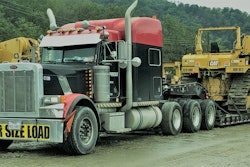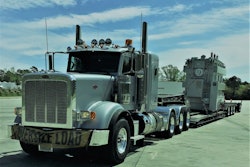Previously in this series: Specialized hauling: Start out light to go heavy
Of the many headaches that can accompany heavy and oversize hauling, one of the biggest involves permits — their many details, as well as state-to-state variances. Consequently, operators’ horror stories abound, such as this one from owner-operator Bruce Arnold.
He was hauling an asphalt burner, making his way across Virginia Beach, Virginia, in 2016. There was a short jog near the end of the route to avoid a small bridge that he and his escorts missed on the permit. While they waited for Chesapeake Bay Bridge Authority personnel at the end of that leg of the trip, he was fined $35,000 by a local authority. It was later reduced to almost $12,000 with the help of attorneys recommended by the Specialized Carriers & Rigging Association.
“I do a lot bigger and heavier stuff” than what he was hauling that day, Arnold says. “Could have easily been a $100,000 ticket with some of it.”
“The bigger and heavier it is, the more complicated it gets,” says owner-operator Kevin Kocmich. You have to follow the permitted route “to a T” or risk a heavy fine.
 It’s common for independent owner-operators, even with more than one truck, to employ a third-party permitting service for procuring permits. However, depending on the level of complication involved, working directly with the state can be relatively easy. Owner-operator Randy Cunha’s familiarity with his home state of Texas and neighboring New Mexico, and the relative ease of Texas’ system, eliminates the necessity of using a permit service there, he says. Similarly, Georgia-based Bruce Arnold says, “If it’s just Georgia and South Carolina, I might order those permits myself.” When they need help on a multistate trip, Arnold and Cunha use Reliable Permit Solutions. Arnold says Reliable charges around $25 per permit on average. Poll results include some leased operators whose carriers are almost twice as likely to have an in-house permit-procurement staff as opposed to using a third-party permit service.
It’s common for independent owner-operators, even with more than one truck, to employ a third-party permitting service for procuring permits. However, depending on the level of complication involved, working directly with the state can be relatively easy. Owner-operator Randy Cunha’s familiarity with his home state of Texas and neighboring New Mexico, and the relative ease of Texas’ system, eliminates the necessity of using a permit service there, he says. Similarly, Georgia-based Bruce Arnold says, “If it’s just Georgia and South Carolina, I might order those permits myself.” When they need help on a multistate trip, Arnold and Cunha use Reliable Permit Solutions. Arnold says Reliable charges around $25 per permit on average. Poll results include some leased operators whose carriers are almost twice as likely to have an in-house permit-procurement staff as opposed to using a third-party permit service.SC&RA has worked for decades toward some semblance of state-to-state harmonization of oversize and overweight permitting. The group’s Uniform Permit Transport 2021 initiative, ongoing now for almost two years, has seen some success with its goal of state-by-state enabling of auto-issue permitting for nondivisible oversize or overweight loads. In 2010, says SC&RA President Ed Bernard, only a few states did such. Now the number’s well over 30, in some cases “for loads of 200,000 pounds or more” and with varying width and length.
The U.S. Department of Transportation measures state auto-permitting processes based on a minimum 150,000-lb. threshold, 14’ wide, 14’6” high and 110’ long. In 2017, before UPT was launched, 20 states met that threshold, with another 10 having some form of automated permitting in place. Since then, another six have added auto-issue systems, Bernard emphasized.
The goal of the UPT 2021 initiative is ultimately about simplicity. One benefit is the potential to free up state resources that could be put to road and bridge improvement efforts, which in turn could enable more practical oversize/overweight routing.
For a cynical observer, support for more practical routes, with fewer opportunities for error, might seem unlikely to come from the states and locales collecting those fines. Yet such a push is on from some state DOTs, alongside that for more automation and simplicity in the permitting processes.
Scott Marion, now retired from the Missouri DOT, makes the case for permit harmonization by emphasizing the potential savings not just for the state but also for the private sector. A zigzagging overweight route from St. Louis to Kansas City, he says, illustrates the large potential mileage reduction with a straight shot. The example has proved effective in making the case that harmonization could deliver untold benefits in fuel, emissions, time and other costs.
The barriers to harmonization in outlier states are many, mostly involving the status-quo inertia endemic to “government bureaucracy,” Marion notes. “Every state has their own permitting rules, and it’s tough to get 50 states to agree on everything.” Some rules might require a legislative change, while state geographies present their own complexities, especially with bridges.
Aside from SC&RA’s efforts, harmonization hasn’t become “a national priority,” Marion says. “A lot of state DOTs … want [road] funding so bad, they don’t want to bring up the subject of big oversize loads, because that scares the public. They don’t even like to mention it.”
Illinois has moved to automated single-trip permitting. Its system might serve as a model for states that haven’t made the move, says Geno Koehler of the Illinois DOT. “We started at 120,000 pounds and auto-routed carriers through the state,” he noted, saving state taxpayers mightily on personnel costs with permit office staff reductions. The state DOT, using a software system, then boosted the weight threshold to 150,000 lbs., covering around 90% of all permitted loads. “Our bridge engineer then allowed us to go up to 299,999 pounds, covering the vast majority of permitted hauls. We’re down to three technicians issuing permits manually.”
When loads don’t fit the auto-issue permit model, “now I’ve got a person to sit down and talk to each one of you,” Koehler told carriers assembled at SC&RA’s annual transportation symposium in February. The system is linked with state law enforcement systems. “They can easily see what kind of permit you have or what violations/out-of-service issues” may be extant.
Next in this series: Oversize/overweight permitting tech tools multiplying









